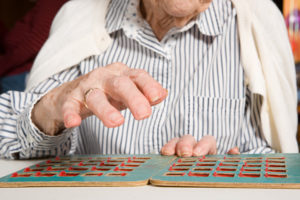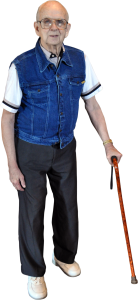The OTvest, Weighted Vest provides Trunk Stability for those with Parkinson’s Disease, Helping Reduce Tremors.
Movement disorders can be debilitating, affecting all areas of everyday life. But the OTvest™ can help naturally treat movement disorders like Parkinson's! The OTvest™ weighted vest is a simple, non-invasive intervention that can improve all aspects of everyday life.
The OTvest™ denim weighted vest can be used as a gentle intervention and natural treatment option for those who suffer from movement disorders such as Parkinson’s disease, other degenerative nervous system or muscular conditions, those that lack body awareness or have cerebellar damage. 
The deep pressure therapy supplied from the weighted vest provides proprioceptive input to the joint receptors, which in turn send messages to the brain about the body’s position. Proprioceptive input allows us to know, without looking at our arm, for example, that our arm is behind us, next to our body, or up in the air. Because deep pressure helps provide proprioceptive input, weighted vests with weights correctly and strategically positioned can, therefore, help improve coordination through the increased awareness of body positioning. This sense of body position, which includes movements of the muscles, tendons, and joints, is called kinesthesia. The OTvest™, with its strategically positioned weights, helps compress the joints and adds sensory stimuli for co-contraction. This allows the OTvest™ to be beneficial for postural stability and increase the wearer’s awareness of where their body is positioned. The added postural stability from the OTvest™ can be used to help naturally treat Parkinson’s.
THE DUAL BENEFITS OF DEEP PRESSURE FOR TREMOR REDUCTION AND TRUNK STABILITY FOR IMPROVED BALANCE
The OTvest™ adds deep pressure on the shoulder blades (scapula), upper back and upper chest of the wearer. This comfortable, deep pressure therapy can be applied any time of the day to improve trunk stability, giving the wearer better balance, improved body awareness and upper extremity function, and reduction of the tremors that are so often associated with movement disorders.
 A weighted vest with a revolutionary patented weight insert, the OTvest™ stabilizes the trunk by applying weight to the shoulder-girdle area, helping control balance and distal movement of the arms and hands. The weight across the back puts mild pressure upon the scapula, which encourages the scapula to lie flatter upon the back, improving trunk stability. When the trunk is stabilized, drinking from a cup, combing one's hair, keyboarding, holding a pencil or spoon, and the other activities of daily living, can be more controlled--especially if due to tremors.
A weighted vest with a revolutionary patented weight insert, the OTvest™ stabilizes the trunk by applying weight to the shoulder-girdle area, helping control balance and distal movement of the arms and hands. The weight across the back puts mild pressure upon the scapula, which encourages the scapula to lie flatter upon the back, improving trunk stability. When the trunk is stabilized, drinking from a cup, combing one's hair, keyboarding, holding a pencil or spoon, and the other activities of daily living, can be more controlled--especially if due to tremors.
THE OTvest IS A NATURAL NON-INVASIVE TREATMENT
If you're looking for a natural treatment option for Parkinson's, the deep pressure touch therapy supplied by the OTvest™ weighted vest might be exactly what you need.
The occupational therapist, N. VandenBerg, MS, OTR (NDT trained, and Bobath trained by Berta and Karel Bobath) who designed the OTvest™, provided occupational therapy treatment to a three year old with encephalitis and very limited vision, who was unable to pick up a toy because of too much uncontrolled arm movement. When the weighted vest was put on, the young child was able to pick up a toy. The OTvest™, with its trunk stabilizing capabilities, improved distal coordination so much that the child was able to play. By being able to pick up a toy, she was gaining the necessary experience with hand and finger manipulation that she would someday need for self-feeding. Persons even in their late 90's are seeing improvement when wearing the OTvest™ when it comes to tremor reduction -- allowing them to comb their hair, drink coffee from a mug, and brush their teeth.
TESTIMONIALS
Those who have used the OTvest™ as a treatment for Parkinson’s have written letters explaining how much the OTvest™ has benefitted their lives. Here are just a few:
“The vest has been amazing. It has actually made my arms usable again...to play the keyboard. [I] learned that if I wear the vest, I have more use of my more affected left hand, and can isolate the keys better...The dystonic movements are almost gone with the [OTvest™] on." Jennifer Zubko, dystonic adult in Canada (ataxic)
"The OTvest™ makes my feet feel more like they are touching the ground. I feel grounded, more secure when walking." Lili Kazepis, Brooklyn, New York cerebellar ataxia
"I got the OTvest™ (sic)…and I was able to sleep through the whole night. Usually, I have to take medication but I haven’t had to touch it since I got the vest. The OTvest™ helps me to stabilize my trunk…with the vest, I am able to walk without swaying back and forth and having to hold on and grab things. It helps give me a feeling of security..it helps me get things done." Robin Stevenson, Gainsville, Florida, cerebellar ataxia (quoted from video, linked below)
"In physical therapy we have been working on stability and core control (with Robin). We have noticed a remarkable difference when walking with the OTvest™ and walking without it. When she first came to physical therapy, she wouldn’t walk in a crowd because she thought she would fall and now she is able to walk through the gym with other patients coming in when she wears the OTvest™. She is far more stable and confident." Eileen Branham, physical therapist, Gainsville, FL (quoted from video, linked below)
"Just received my OTvest™ less than an hour ago. I love it and can already tell I am using my arms better. I am even being more accurate with the keyboard as I sit to type this. My PT and therapeutic riding instructor have been working very hard on my shoulders and arms this week, as they were extremely tight. I put on the vest and they went immediately limp. It is as if I don't have any tone at all in that area, which of course, has calmed my whole system down. The vest feels very much like my therapists hands constantly on my shoulders. First impressions are that I love it! I don't want to take it off!" Thank you for everything. Jennifer Zubko, Canada
"The vest seems to keep me straight not going to one side like I do. It makes me walk more straight without leaning towards one side. I am 50, had Ataxia SCA1 since 38, 130 pounds, wear 10 or 12. The vest has the 3 pounds… It works good with keeping me more balanced and grounded. My muscles are very weak and sore from the ataxia. I also can't button things. The snaps work great." Cathy Letson, Sca 1 ataxia, Claxton, GA 6/16
 RESEARCH
RESEARCH
Research has shown that weight applied in the shoulder area of persons with cerebellar ataxia, including those with multiple sclerosis, improved their lateral (side-to-side) sway when six pounds of weight was applied (Lucy and Hayes, 1985). Another study demonstrated improvement in lateral sway using even less weight (Widener, Allen, Gibson-Horn, 2009). There are more references at the bottom of this page.
VIDEO WALKING WITH AND WITHOUT WEARING THE OTvest
Robin, an OTvest™ wearer with cerebellar ataxia, began wearing the weighted vest in the hopes that it would reduce her lateral sway. The OTvest™ provided such an effective treatment for cerebellar ataxia in her case that Robin no longer needs to hold onto a wall or depend on support from her physical therapist when she wears the OTvest™. Robin’s before and after experience wearing the weighted vest was recorded and is demonstrated below.
In this video, Robin is wearing an OTvest™ size medium with 4lbs of weight.
Place an order by clicking here.
Look for the yellow "OTvest™" label on the chest pocket to make sure you are getting the genuine OTvest™. Others may look like the OTvest™ from the outside, but the weight placement is important. Only the OTvest™ has the patented weighted insert with weight lying directly upon the body. This makes the difference!
Note: The OTvest™ is not recommended for those with spinal cord problems and the accompanying balance problems associated with those disorders, such as herniated or dislocated discs, degenerative disc disease, or other spinal cord injuries. The balance problems that benefit from the OTvest, weighted vest are those with upper motor neuron and/or cerebellar problems described in the first paragraph.
References:
Chase RA, Cullen JK, Sullivan SA. Modification of intention tremor in man, Nature 1965;4983:485-7.
Clopton N, Schultz D, Boren C, Porter J, Brillhart T. Effects of axial loading on gait for subjects with cerebellar ataxia: preliminary findings. Neurol Report 2003;27:15-21.
Gillen, G. (2000). Improving activities of daily living performance in an adult with ataxia. American Journal of Occupational Therapy (54)1:89-94.
Hewer RL, Cooper R, Morgan MH. An investigation into the value of treating intention tremor by weighting the affected limb.,Brain 1972;95:570-90.
Lucy SD, Hayes KC. Postural sway profiles: normal subjects and subjects with cerebellar ataxia. Physiother Can 1985;37: 140-8.
Morgan MH, Hewer RL, Cooper R. Application of an objective method of assessing intention tremor–a further study on the use of weights to reduce intention tremor. J Neurol Neurosurg Psychiatry 1975;38:259-64.
Morgan MH. Ataxia and weights, Physiotherapy 1975;61: 332-4.
Smedal T, Lydren H, Myhr KM, et al. Balance and gait improved in patients with MS after physiotherapy based on the Bobath concept. Physiother Res Int 2006;11:104-16.
Widener GL, Allen DD, Gibson-Horn C. Balance-based torso-weighting may enhance balance in persons with multiple sclerosis: preliminary evidence. Arch Phys Med Rehabil 2009;90:602-9.
